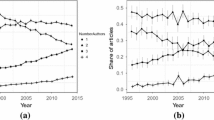Abstract
Thanks to a unique individual dataset of French academics in economics, we explain individual publication and citation records by gender and age, co-authorship patterns (average number of authors per article and size of the co-author network) and specialisation choices (percentage of output in each JEL code). The analysis is performed on both EconLit publication scores (adjusted for journal quality) and Google Scholar citation indexes, which allows us to present a broad picture of knowledge diffusion in economics. Citations are largely driven by publication records, which means that these two measures are partly substitutes, but citations are also substantially increased by larger research team size and co-author networks.
Similar content being viewed by others
Notes
Ministère de l’Enseignement Supérieur et de la Recherche–Direction Générale de la Recherche et de l’Innovation.
We matched data from the Universities, from the CNRS (Centre National de la Recherche Scientifique) and from the INRA (Institut National de la Recherche Agronomique).
In logarithms to match the econometric analysis presented in “Econometric specification”.
The academics who have never co-authored an article have a network of size 0, so we add 1 to Net i to take its log. 1 + Net i can be seen as the total network size, including academic i who would belong to her/his own network in this case.
We ignore the fields “Miscellaneous Categories” (Y) and “Other Special Topics” (Z). We also slightly modify the codes C and D by merging code C7 (Game Theory and Bargaining Theory) and C9 (Design of Experiments) with Microeconomics (D), which seems to us more consistent.
We estimate the γ j coefficients under the constraint ∑ 18 j = 1 γ j = 0. Therefore significance tests reported for the γ j are with respect to the average γ j .
1.5−0.262 − 1, 1.50.200 − 1 and 1.50.773 − 1, respectively.
1.50.266 − 1, 1.51.671 − 1, 1.51.056 − 1 and 1.50.861 − 1, respectively.
1.250.132 − 1 and 1.250.644 − 1, respectively.
1.20.216 − 1 and 1.20.789 − 1, respectively.
The number of observations in the regressions falls slightly because some academics have only published articles for which JEL codes are not recorded in EconLit.
1.250.907 − 1 and 1.250.503 − 1, respectively.
1.10.221 − 1 and 1.10.126 − 1, respectively.
1.50.229 − 1 and 1.50.460 − 1, respectively.
1.20.303 − 1 and 1.20.225 − 1, respectively.
\(\frac{1.021}{1.756}=0.581, \,\frac{1.037}{1.756}=0.591, \,\frac{0.532}{0.988}=0.538, \,\frac{0.544}{0.988}=0.551\)
\(\frac{0.514}{0.284} = 1.810, \,\frac{0.516}{0.283} = 1.823\)
\(\frac{0.539}{0.256} = 2.105, \,\frac{0.537}{0.255} = 2.106\)
References
Abramo, G., d’Angelo, C. A., & di Costa, F. (2010). Citations versus journal impact factor as proxy of quality: Could the latter ever be preferable? Scientometrics, 84(3), 821–833.
Amara, N., & Landry, R. (2012). Counting citations in the field of business and management: Why use google scholar rather than the web of science. Scientometrics, 93(3), 553–581.
Badar, K., Hite, J. M., & Badir, Y. F. (2013). Examining the relationship of co-authorship network centrality and gender on academic research performance: The case of chemistry researchers in Pakistan. Scientometrics, 94(2), 755–775.
Bramoullé, Y., Djebbari, H., & Fortin, B. (2009). Identification of peer effects through social networks. Journal of Econometrics, 150(1), 41–55.
Combes, P.-P., & Linnemer, L. (2010). Inferring missing citations. A quantitative multi-criteria ranking of all journals in economics. GREQAM Working Paper (2010-25).
Combes, P.-P., Linnemer, L., & Visser, M. (2008). Publish or peer-rich? The role of skills and networks in hiring economics professors. Labour Economics, 15(3), 423–441.
Diamond, A. M. (1986). What is a citation worth? Journal of Human Resources, 21(2), 200–215.
Egghe, L. (2006). Theory and practise of the g-index. Scientometrics, 69(1), 131–152.
Egghe, L., Guns, R., & Rousseau, R. (2013). Measuring co-authors’ contribution to an article’s visibility. Scientometrics. doi:10.1007/s11192-012-0832-4.
Hamermesh, D. S., Johnson, G. E., & Weisbrod, B. A. (1982). Scholarship, citations and salaries: Economic rewards in economics. Southern Economic Journal, 49(2), 472–481.
Hansen, W. L., Weisbrod, B. A., & Strauss, R. P. (1978). Modeling the earnings and research productivity of academic economists. Journal of Political Economy, 86(41), 729–741.
Harzing, A.-W. (2013). A preliminary test of Google Scholar as a source for citation data: A longitudinal study of nobel prize winners. Scientometrics (forthcoming).
Hirsh, J. (2005). An index to quantify an individual’s scientific research output. Proceedings of the National Academy of Sciences, 102, 16569–16572.
Katz, D. A. (1973). Faculty salaries, rates of promotion and productivity at a large university. American Economic Review, 63(3), 469–477.
Kenny, L. W., & Studley, R. E. (1995). Economists’ salaries and lifetime productivity. Southern Economic Journal, 62(2), 382–393.
Lovell, M. C. (1973). The production of economic literature: An interpretation. Journal of Economic Literature, 11(1), 27–55.
McDowell, J. M., & Smith, J. K. (1992). The effect of gender-sorting on propensity to coauthor: Implication for academic promotion. Economic Inquiry, 30(1), 68–82.
Mishra, V., & Smyth, R. (2013). Are more senior academics really more research productive than junior academics? Evidence from Australian law schools. Scientometrics, 94(2), 755–775.
Sauer, R. D. (1988). Estimates of the returns to quality and coauthorship in economic academia. Journal of Political Economy, 96(4), 855–866.
Schreiber, M. (2008). To share the fame in a fair way, hm modifies h for multi-authored manuscripts. New Journal of Physics, 10(4), 040201-1–040201-8.
Stigler, G. J., & Friedland, C. (1975). The citation practices of doctorates in economics. Journal of Political Economy, 83(3), 477–507.
van Arensbergen, P., van der Weijden, I., & van den Besselaar, P. (2012). Gender differences in scientific productivity: A persisting phenomenon? Scientometrics, 93(3), 857–868.
Zinovyevay, N., & Bagues, M. (2012). It’s not what you know, but who you know: The role of connections in academic promotions. IZA Working Paper 6821.
Acknowledgments
The authors are very grateful to Philippe Donnay and Charles Laitong for their excellent research assistance.
Author information
Authors and Affiliations
Corresponding author
Appendix
Appendix
See Tables 9, 10, 11, 12, 13 and 14.
Rights and permissions
About this article
Cite this article
Bosquet, C., Combes, PP. Are academics who publish more also more cited? Individual determinants of publication and citation records. Scientometrics 97, 831–857 (2013). https://doi.org/10.1007/s11192-013-0996-6
Received:
Published:
Issue Date:
DOI: https://doi.org/10.1007/s11192-013-0996-6




